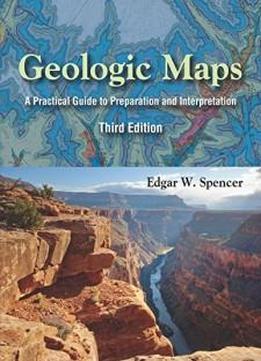
Geologic Maps: A Practical Guide To Preparation And Interpretation, Third Edition
by Edgar W. Spencer /
2017 / English / PDF
350.2 MB Download
Geologic maps supply a wealth of information about the surface and
shallow subsurface of the earth. The types of materials that are
present in a location and the three-dimensional structure of the
bedrock both can be gleaned from a clearly prepared geologic map.
Geologists, civil and environmental engineers, land-use planners,
soil scientists, and geographers commonly use geologic maps as a
source of information to facilitate problem solving and identify
the qualities of a region. Maps reveal the position of many types
of natural hazards, indicate the suitability of the land surface
for various uses, reveal problems that may be encountered in
excavation, provide clues to the natural processes that shape an
area, and help locate important natural resources.
Geologic maps supply a wealth of information about the surface and
shallow subsurface of the earth. The types of materials that are
present in a location and the three-dimensional structure of the
bedrock both can be gleaned from a clearly prepared geologic map.
Geologists, civil and environmental engineers, land-use planners,
soil scientists, and geographers commonly use geologic maps as a
source of information to facilitate problem solving and identify
the qualities of a region. Maps reveal the position of many types
of natural hazards, indicate the suitability of the land surface
for various uses, reveal problems that may be encountered in
excavation, provide clues to the natural processes that shape an
area, and help locate important natural resources.
Suitable for lab courses in structural geology as well as field
geology work, Spencer describes representative examples of
features found on geologic maps and outlines procedures for
interpretation and projection. Geometric techniques are explained
using a step-by-step approach. Coverage of mapping methods
includes tools that provide necessary data, such as Google Earth,
GPS, GIS, LiDAR maps, drones, and aerial photographs. Challenging
and engaging exercises throughout the text involve students in
the mapping process and stimulate an appreciation of the extent
and precision of information presented in geologic maps.
Suitable for lab courses in structural geology as well as field
geology work, Spencer describes representative examples of
features found on geologic maps and outlines procedures for
interpretation and projection. Geometric techniques are explained
using a step-by-step approach. Coverage of mapping methods
includes tools that provide necessary data, such as Google Earth,
GPS, GIS, LiDAR maps, drones, and aerial photographs. Challenging
and engaging exercises throughout the text involve students in
the mapping process and stimulate an appreciation of the extent
and precision of information presented in geologic maps.
Regional geology is an important component of lab and field
mapping projects. As such, the Third Edition includes new maps of
the Gulf of Mexico Coastal Plain, Rocky Mountain Front Range,
Yellowstone region, Moab, Utah, Shenandoah National Park, and
Hawai'i. A new chapter devoted to tectonic maps also broadens
students' exposure. Ed Spencer brings over 45 years of teaching
experience to the text along with valuable insight and clarity
into the interpretation and preparation of geologic maps.
Regional geology is an important component of lab and field
mapping projects. As such, the Third Edition includes new maps of
the Gulf of Mexico Coastal Plain, Rocky Mountain Front Range,
Yellowstone region, Moab, Utah, Shenandoah National Park, and
Hawai'i. A new chapter devoted to tectonic maps also broadens
students' exposure. Ed Spencer brings over 45 years of teaching
experience to the text along with valuable insight and clarity
into the interpretation and preparation of geologic maps.











